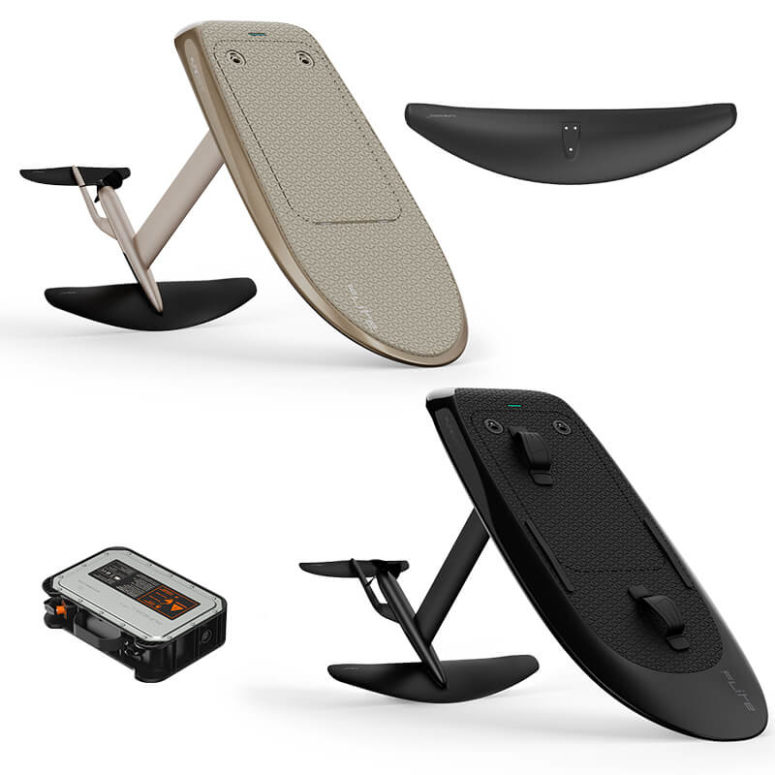

When you purchase gear through links on our site, we may earn a small commission. Here’s why you can trust our tests and our affiliate partner.

I recently headed up to Fliteboard HQ at Byron Bay to test out their newest Series 3 range of electric hydrofoils. Catching up for coffee and sharing a few waves with Flite founder, David Trewern, I was able to get an insight into an incredible company culture focused on user experience and constant design progression.
We tested the Fliteboard Pro and Ultra L boards with Flitecell Sport and Nano batteries, and flew the Cruiser 1100 and Cruiser Jet 1500 wings underneath it all. Conditions were a dreamy 2-3ft, with unbroken right handers peeling down The Pass. Local Flite-shredder Adam Bennetts even came out to show me the ropes on how to rip these wings hard!
Starting off with the Fliteboard Pro with Sport Battery on the Cruiser 1100 wing, this setup weighs in at 29.8kg, and is a beautiful beginner’s choice, with enough juice for 1.5 hours ride time and a very easy slow lift off that makes learning a breeze. With great ride stability and predictable pitch control, it can still go up to around 27km/hr and carve really nice S-turns through waves.
Switching to the Cruiser Jet 1500 wing, designed to work with the Flite Jet (which swaps out the existing TrueGlide prop on the Flite mast) this wing felt so smooth and buttery to ride. Jet propulsion has a slightly different feel to the conventional prop – it operates better at high speed, but doesn’t have as much low-down grunt to get going. This is why the Cruiser Jet 1500 has a little more surface area, to help with takeoff. Once up, this wing and propulsion combo are so, so smooth, with minimal motor noise and less turbulence through turns, also reacting better when accidentally releasing the stabilizer out of the water. With a slightly higher aspect ratio than the Cruiser series, it has a lot of glide yet can turn surprisingly hard and sharp. When riding de-powered on waves, this wing and jet combo feels like it has really low drag, so for advanced riders, wave-riding can be prioritized and battery can be conserved, prolonging the session.
Weight is everything in foiling and e-foiling, contributing to responsiveness, agility, takeoff speed, not to mention carrying the board to the water’s edge! Sacrificing ride-time for performance, on the Pro we swapped out the Flitecell Sport Battery with the company’s newest Flitecell Nano, which weighs in at only 6.2kg. This caused a noticeable improvement in the ride quality, swing weight and carving ability during subsequent water testing, albeit with an understandable reduction in ride time (about 45 mins) due to the smaller battery size.
The Nano was designed with weight in mind, which brings me to the Fliteboard Ultra Carbon, another of Flite’s newest weapons in board design. This is a performance setup, some might call it the Holy Grail of e-foil setups in 2023, designed for those individuals and advanced riders who go e-foiling to go big. Weighing in at only 22.5 kg together with the Nano, this is one of lightest setups out there, and I could feel this straight away when testing it for the first time. Turns were on another level, even on the same Cruiser and Cruiser Jet wings, and underfoot these boards are so nimble and responsive to the slightest input. Coming from a prone/SUP/downwind background, the Ultra Carbon even enabled me to feel the little bumps and bits of wave energy in the water below, which is not something you can usually feel when riding an e-foil. With its double concave hull design, this board also glances off the water really well and is very controlled through sharp turns. Progression in the sport may revolve around the Ultra Carbon this year, with some Flite rippers riding with attitude – popping airs, hitting breakneck speeds and absolutely sending it on bigger waves.
What most impressed me about the new Fliteboard range was the user experience and the nifty design ideas that David and the team have integrated into these products. The battery connects to the board via two cables, it’s as simple as that. The unique mast design with its integrated (FliteBox) speed controller, ensures the electronics are cooled as the aluminum glides through the water, eliminating the need for cooling tubes. The hand controller is very simple to use and pair, and beginners can get used to the speed control sensitivity by holding the trigger fully depressed and cycling up through the gears, while advanced riders can transition to feathering the trigger for ultimate control. Even the custom-designed latches securing the battery lid to the board are satisfying to use. When looking at these boards, the build quality is unquestionable, and the twist-on dual-propulsion option with the Jet vs Prop combos is a game-changer for customisation.
Overall, the refinement of these products is impressive, and the Series 3 range does a good job at covering all bases, for all types of e-foilers. Through their great product design and innovation, Flite is a company that continues to achieve global success while staying true to its Byron Bay roots. JK
For a more detailed review of the Fliteboard Ultra L, head here.